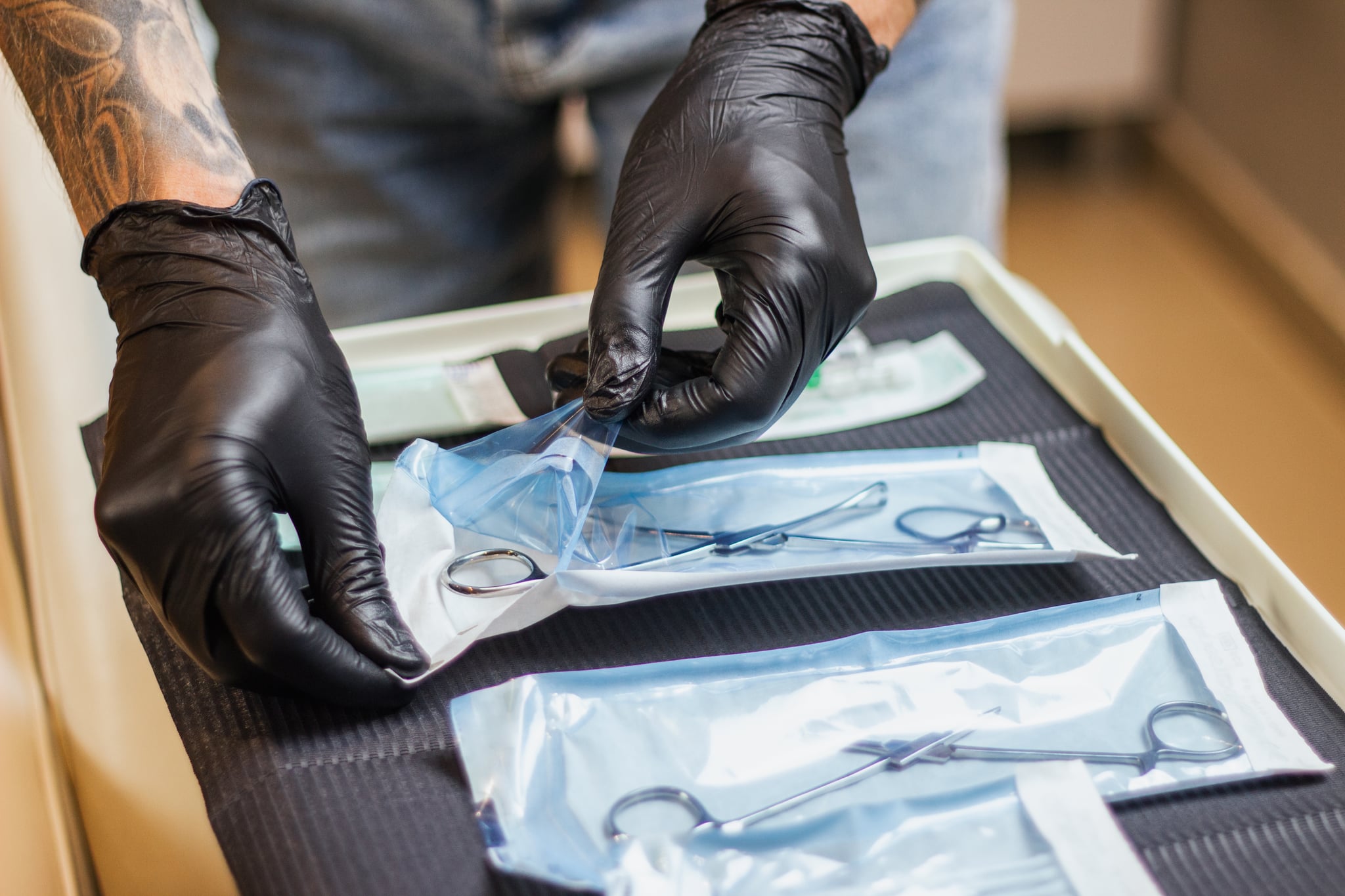- Nape piercings are a type of surface piercing that’s done on the back of the neck.
- The piercing features two puncture holes with a bar running under the skin.
- Learn about application, aftercare, and pain level from a professional piercer.
Growing up, you may have been under the impression that the extent of body piercings encompasses ear piercings and maybe even belly button rings, but you might not have known just how many different types there are out there. There are multiple types of eyebrow piercings, lip piercings, nose piercings, dermal piercings, and even genital piercings, but have you ever heard of nape piercings?
This type of body modification is done on the back of the neck. Though it can look similar to a dermal, it’s a surface piercing that uses a bar to connect two separate holes. It’s certainly more advance than, say, a classic ear lobe piercing, but it’s not as invasive as a dermal. You can think of it kind of like a belly button piercing in that way.
To learn more about this type of piercing, we tapped Elayne Angel, a professional piercer and Author of “The Piercing Bible — The Definitive Guide to Safe Piercing.” Keep reading to get the scoop on the trendy nape piercing.
What Is a Nape Piercing?
Nape piercings are done on the back of the neck with the bar sitting horizontally or vertically just under the surface of the skin. “A surface bar is the most common jewelry style used for this placement,” Angel tells POPSUGAR. “They are one of the few surface piercings that will routinely stay in place for decades without migration or other issues.”
The way a nape piercing is inserted is pretty similar to a naval piercing. “The area is prepped with a surgical scrub or soap and marked with the placement,” says Angel. “The piercer will either use forceps or their fingers to secure the tissue; then, they make the piercing with a sterile, disposable needle.” The piercing goes in one hole, under the skin, and out a different hole. Then, the jewelry is added.
Do Nape Piercings Hurt?
As with all piercings (and tattoos, for that matter), the pain level is subjective. “Most of the clients I performed them on described the procedure as a pressure sensation and not particularly painful,” says Angel. “It is definitely not the most sensitive spot on the body that gets pierced.” That said, it certainly won’t feel good, but it shouldn’t be unbearable.
“When you go to a skillful professional, the procedure is very brief, and the sensation dissipates rapidly,” Angel says. “Afterward, there is seldom much soreness.”
https://www.instagram.com/p/CX-rECyqhPU/
Nape Piercing Healing Time
Nape piercings take longer than most piercings to heal — especially traditional ear piercings. Angel says about six to nine months or more is standard. “Some patience is required, but if they’re subject to a minimum of trauma and cared for properly, they tend to heal well.”
Nape Piercing Aftercare
Proper aftercare is key to helping your piercing heal well and quickly. Though any type of break in the skin, intentional or unintentional, is susceptible to infection, Angel says “nape piercings are not more likely to become infected than other areas.” The biggest thing to keep in mind: “they’re not especially difficult to heal — they just take a fair bit of time.”
Angel likes to treat nape piercings the same as all body piercings. Instead of routinely cleaning the sight with sterile saline solution, Angel recommends “a product that is far more germicidal and that does more to promote healing,” like the Briotech Aftercare Spray ($14). It contains the skin-healing ingredient hypochlorous acid. “This is the same anti-inflammatory and broad-spectrum germicide that is made by our own white blood cells as part of our immune system,” says Angel. “It quickly destroys all known pathogens but is so compatible with the body it can be used in the eyes, nose, and mouth. Studies also show it accelerates wound healing and helps to minimize scarring.”
As for additional aftercare tips you should follow after the appointment, Angel recommends you change your bedding regularly, avoid swimming, and ensure nothing is worn that can cause trauma or irritation to the piercing on the back of your neck, like jewelry or tight clothing. “Keep hair away from the jewelry as much as possible and make certain no strands or threads get wrapped around the bar.”
The Risks of Nape Piercings
Aside from the risk of infection if it’s not cared for properly, there’s one other risk you should look out for — but it can be avoided by going to a professional, experienced piercer. “If a nape piercing is done too deep, there is a risk of damaging nerves, including the spinal accessory nerve (responsible for muscle function) and cutaneous nerves (responsible for scalp sensation),” says Angel. “Additionally, there are numerous planes of fascia (connective tissue) below the surface that could potentially carry infection to other areas of the body. Therefore, it is vital that you go to a qualified professional piercer.”
Source: Read Full Article


